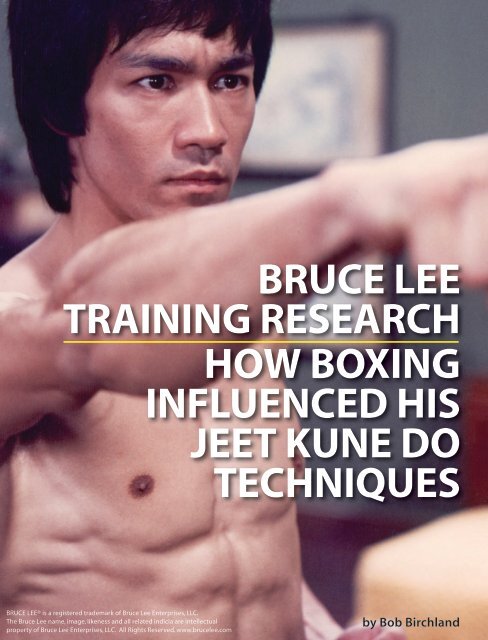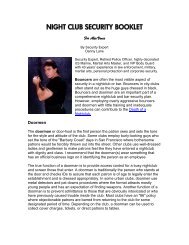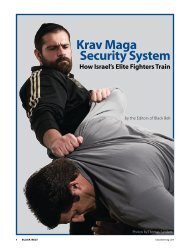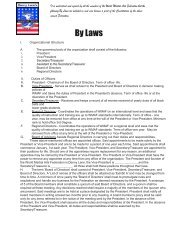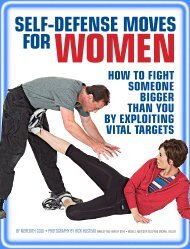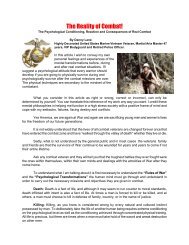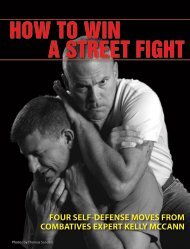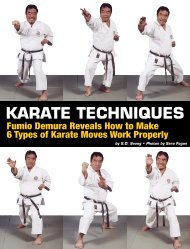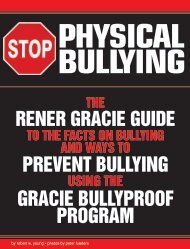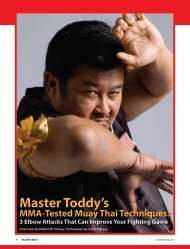bruce lee training research how boxing influenced his - Danny Lane
bruce lee training research how boxing influenced his - Danny Lane
bruce lee training research how boxing influenced his - Danny Lane
You also want an ePaper? Increase the reach of your titles
YUMPU automatically turns print PDFs into web optimized ePapers that Google loves.
BRUCE LEE<br />
TRAINING RESEARCH<br />
HOW BOXING<br />
INFLUENCED HIS<br />
JEET KUNE DO<br />
TECHNIQUES<br />
BRUCE LEE® is a registered trademark of Bruce Lee Enterprises, LLC.<br />
1 BLACK BELT blackbeltmag.com<br />
The Bruce Lee name, image, likeness and all related indicia are intellectual<br />
property of Bruce Lee Enterprises, LLC. All Rights Reserved. www.<strong>bruce</strong><strong>lee</strong>.com<br />
by Bob Birchland
Bruce Lee was never a professional boxer —<br />
although he did fight throughout high school<br />
and was an avid student of <strong>boxing</strong> during <strong>his</strong><br />
adult life. Because <strong>his</strong> jeet kune do was greatly <strong>influenced</strong><br />
by the fighting styles he studied, <strong>his</strong> interest in <strong>boxing</strong><br />
leads to a question: Just <strong>how</strong> good was Lee as a boxer?<br />
His skill and prowess as a martial artist are wellknown.<br />
The manner in which he took over the direction<br />
of <strong>his</strong> second film and revolutionized the way the fights<br />
were presented in the Mandarin pictures is a matter of<br />
record. But there’s a vocal minority who say Lee wasn’t a<br />
particularly skilled fighter — that he could choreograph<br />
a fight for the screen but that when it came to applying<br />
techniques in real fighting situations, he was a wash. To<br />
refute these claims, it seems that Lee’s skill as a boxer<br />
becomes a crucial point.<br />
It’s no secret that Lee scrutinized old films of famous<br />
boxers, integrating the moves into <strong>his</strong> own method of<br />
fighting. One of <strong>his</strong> favorite fighters was Muhammad<br />
Ali, who in Lee’s opinion developed the most intricate<br />
patterns of movement. Knowing what Lee thought of<br />
Ali gives us a glimpse of <strong>how</strong> he might have interjected<br />
some of Ali’s prowess into <strong>his</strong> fighting, but <strong>how</strong> does<br />
Ali’s opinion of Lee fit the man who copied some of the<br />
boxer’s style? In a brief interview, the question was put<br />
to Ali, and t<strong>his</strong> is what he had to say:<br />
“I understand he watched some of my fight films. You<br />
know, I don’t think he’d use too much of that <strong>boxing</strong><br />
stuff in real life. I saw him in a karate movie, but I know<br />
that stuff is just acting. It’s colorful and good s<strong>how</strong>manship,<br />
and if I were a karate man, I’d want to be just like<br />
those guys in the movies, tackling 25 guys and making<br />
them all scatter. All that action makes you want to fight,<br />
but he wouldn’t do that in real life. Watching real karate<br />
fights is not like what you see in the movies, where a guy<br />
jumps in and does some superhuman stunts. That’s the<br />
movies, not real life.”<br />
The mystique of Lee has permeated the martial arts<br />
like nothing before or since. Karate champion Joe Lewis,<br />
who knew Lee for many years, has a mellow opinion of<br />
him.<br />
“In the beginning,” Lewis says, “Bruce and I became<br />
friends, and we had some differences. Later, we put<br />
those differences aside and resumed our friendship. All<br />
anyone can say about him is that he was a great theorist<br />
and <strong>his</strong> theories work very well. But then, of course, is the<br />
fact that Bruce never fought in competition, so you can’t<br />
really tell <strong>how</strong> he would have done.<br />
“I think he would have made a relatively good fighter<br />
because of <strong>his</strong> speed. He could have been a good featherweight<br />
or lightweight, rated one or two in the ranks.<br />
But then he would’ve been obscure because most of<br />
the public’s interest is focused on the heavier weights.”<br />
The best one can do, now that Lee is no longer here<br />
to demonstrate <strong>his</strong> skill, is to build a case through those<br />
who knew and worked with him. Two of <strong>his</strong> associates<br />
who are qualified to shed some light on <strong>his</strong> fighting ability<br />
are Dan lnosanto and Richard Bustillo.<br />
Inosanto and Bustillo met Lee in 1966 while he was<br />
doing The Green Hornet TV series. Once they became<br />
friends, Lee introduced them to jeet kune do. They grew<br />
under <strong>his</strong> guidance and soon became instructors. Both<br />
men have the highest respect for Lee’s fighting ability,<br />
but we’ll let them speak for themselves.<br />
INOSANTO: We used to go to <strong>his</strong> house on Wednesdays.<br />
We started off there, and we’ve been at it ever<br />
since. About that time, Bruce was beginning to develop<br />
<strong>his</strong> collection of <strong>boxing</strong> films. He had one of the biggest<br />
collections in the country.<br />
BUSTILLO: The way Bruce used to analyze those<br />
films — we could only take it for a couple of hours, but<br />
Bruce could sit there for eight or 10 hours and still s<strong>how</strong><br />
the same interest and enthusiasm he s<strong>how</strong>ed in the first<br />
five minutes. He’d go over and over those fight films,<br />
and he could imitate any of the fighters he was watching.<br />
The Ali shuffle, the Sharkey roll, Sugar Ray’s bob and<br />
weave, the Brown Bomber’s six-inch punch, Kid Gavilan’s<br />
bolo punch and any others that caught <strong>his</strong> trained eye.<br />
INOSANTO: Muhammad Ali was probably <strong>his</strong> favorite<br />
fighter, but Bruce took something from everybody.<br />
He liked Ali’s footwork and admired <strong>his</strong> outside fighting.<br />
He liked Marciano’s short punches. He used to study all<br />
the knockout punches of Joe Louis.<br />
BUSTILLO: Boxing, Western fencing and wrestling —<br />
Bruce Lee studied them all. In each art was a kernel of<br />
the truth he was trying to demonstrate. The totality is<br />
Bruce’s art.<br />
2 BLACK BELT blackbeltmag.com
INOSANTO: He had to know the answers.<br />
When anyone really searches for the<br />
truth as he did, he begins to see all facets.<br />
He was able to see all, to see the totality.<br />
BUSTILLO: The deeper he studied, the<br />
more involved he got, the more scientific he<br />
became. Everything he found out, he always<br />
asked himself t<strong>his</strong> question: How or why? If<br />
he saw a left lead in a fight film, he’d turn<br />
<strong>his</strong> back to the screen and watch through<br />
a mirror. That would s<strong>how</strong> him <strong>how</strong> the<br />
right lead should look — <strong>how</strong> and when it<br />
should be thrown.<br />
INOSANTO: He always asked, “Why is it<br />
done t<strong>his</strong> way?” The why led him to more<br />
questions and in turn to more answers.<br />
Ninety percent of the people in the martial<br />
arts don’t ask why. If they happen to study<br />
with a guy in their neighborhood, they take<br />
what he presents as the truth. It’s a part of<br />
the truth, but it’s not the whole truth.<br />
We never questioned our instructor. If he<br />
told us to stand on our heads, we’d do it —<br />
that’s the classical approach. But Bruce Lee<br />
was always questioning. It’s not that he embraced<br />
Western <strong>boxing</strong> completely. He felt<br />
there were many flaws in <strong>boxing</strong>, too. But he<br />
also felt that out of all the arts in the hand<br />
range, <strong>boxing</strong> had more truth than, let’s say,<br />
karate. Not that karate was all flaws — he<br />
saw the truth in karate, too. But he would<br />
take the best of everything. He was developing<br />
the complete martial art.<br />
Actually, I didn’t think too highly of <strong>boxing</strong><br />
before I met Bruce. I’d boxed some at<br />
the Y, but I didn’t appreciate the art. Bruce<br />
had been the interschool <strong>boxing</strong> champion<br />
while he was in high school in Hong Kong.<br />
Out of 15 schools, he was No. 1. He knew<br />
<strong>how</strong> effective <strong>boxing</strong> could be.<br />
BUSTILLO: There’s a good reason why<br />
most people don’t have any regard for <strong>boxing</strong><br />
today — because today’s fighters are all<br />
3 BLACK BELT blackbeltmag.com<br />
Richard Bustillo (left) / Photo by Rick Hustead
courage and guts. There’s no skill and class. There’s no<br />
scientific moves, clever punches, plan of attack or strategy.<br />
Today, the guy who opens the fastest and hits the<br />
hardest is the guy who wins. Probably, Ali is one of the<br />
very few real scientific boxers left.<br />
INOSANTO: Most people aren’t aware of it, but Bruce<br />
was very into <strong>boxing</strong>. Scientific <strong>boxing</strong>. He taught <strong>boxing</strong><br />
at <strong>his</strong> school. Even with t<strong>his</strong> interest in <strong>boxing</strong>, <strong>how</strong>ever,<br />
he never went to the fights. But he did watch the fights<br />
on TV whenever he could.<br />
His theory of <strong>training</strong> was<br />
through self-discovery. He’d<br />
spar with anybody he could.<br />
All <strong>his</strong> technique was derived<br />
through self-discovery. He used<br />
to call it “discovering the source<br />
of your ignorance.” Anybody<br />
who would visit him, he’d spar<br />
with them — with or without<br />
the gloves.<br />
BUSTILLO: Bruce would<br />
probably have gone to the <strong>boxing</strong><br />
gyms around here, but as I<br />
said, he liked scientific <strong>boxing</strong>.<br />
The majority of the guys at the<br />
gyms are not schooled; they’re<br />
not aware of what they should<br />
be looking for when sparring<br />
or what they should be trying<br />
to accomplish. Bruce had the<br />
interest, the dedication, the<br />
ready-willing-and-able attitude<br />
to be a top world contender.<br />
INOSANTO: People ask,<br />
“Why, if he had t<strong>his</strong> interest in<br />
<strong>boxing</strong>, didn’t he become a<br />
professional fighter?” Boxing<br />
was not a totality — just as<br />
wrestling and karate are not totalities.<br />
For Bruce to have gone<br />
into professional <strong>boxing</strong> would<br />
be like asking a chess champion<br />
to participate in a checkers<br />
tournament. It’s a different<br />
realm. Boxing wasn’t <strong>his</strong> game.<br />
Although he was an excellent<br />
boxer and he felt there was a<br />
lot of merit in it, there were still<br />
some things wrong with the<br />
4 BLACK BELT blackbeltmag.com<br />
Dan Inosanto (right) / Photo by Markus Boesch
art. There’s more slugging, and you’ve got to push more<br />
with your gloves. Boxing, he felt, was over-daring, whereas<br />
he found karate to be overprotective.<br />
BUSTILLO: That’s <strong>how</strong> he developed jeet kune do.<br />
He put all the arts together. Kicking distance, he taught,<br />
comes first. You have the longest reach with your feet.<br />
Close the kicking range, and you’re in hand distance.<br />
That’s where the <strong>boxing</strong> comes in. All the moves that are<br />
used in <strong>boxing</strong> would be good in JKD, along with the<br />
hand, arm and elbow moves that are used in gung fu.<br />
After hand range, wrestling or judo comes in.<br />
INOSANTO: And that’s important. It is easier to train<br />
a boxer to kick — or at least to counter a kick — than it<br />
is to train a karateka to box. Within six months, a boxer<br />
would do well against most people schooled in karate.<br />
Wrestlers are in tremendous condition. Professional<br />
wrestling is a s<strong>how</strong>, but don’t underestimate the skill of<br />
the professional wrestler. They’re in tremendous condition<br />
— they have to be to put on a s<strong>how</strong> like that. And<br />
those holds are not fake; they’re real. I’d put my money on<br />
a professional wrestler against someone schooled in karate.<br />
There are a lot of weaknesses in karate. Bruce felt that<br />
there are a lot of talented people in karate; what we’re<br />
trying to say is that a lot of them are not aware of the different<br />
kinds of fighting conditions they might come up<br />
against. They’ve never been exposed to what it’s like.<br />
BUSTILLO: That’s why Bruce was something new<br />
and different in the martial arts. He always wanted to<br />
know everything, to incorporate different elements into<br />
<strong>his</strong> fighting style. I like to say he was like Jonathan Livingston<br />
Seagull; he always wanted to go one step more<br />
in finding out about the martial arts. The two vehicles of<br />
Bruce Lee were <strong>his</strong> <strong>training</strong> and reading. The walls of <strong>his</strong><br />
office were filled with books on the martial arts.<br />
INOSANTO: Getting back to the original question,<br />
there’s no doubt in my mind that if Bruce Lee had gone<br />
into pro <strong>boxing</strong>, he could easily have ranked in the top<br />
three in the lightweight division or junior-welterweight<br />
division. When he first came to Los Angeles, he weighed<br />
about 150 pounds on a 5-foot-7-inch frame. When he<br />
went back to Hong Kong, he was down to 126, and he<br />
packed almost unbelievable power behind that weight.<br />
But Bruce was first a martial artist, and he went out of<br />
<strong>his</strong> way to prove that he really had a method of fighting,<br />
that it was as disciplined and more scientific than<br />
the older, classical arts. Jeet kune do is a very elusive<br />
term because it is more than <strong>boxing</strong>. We use the feet,<br />
the hands and grappling. Bruce said: “There’s a beauty in<br />
everything. The name is insignificant. Why don’t they just<br />
give one name to all the arts and call it ‘fighting’? The<br />
human name for anything is the most corrupt form. Jeet<br />
kune do is just a name, and if you do not like that name,<br />
then let it be dropped.”<br />
So there you have it from two of the Little Dragon’s closest associates. Lee sought the truth in creating a truly effective<br />
fighting form. He studied and mastered all the arts, and he had a special regard for <strong>boxing</strong> because of the truth that<br />
<strong>boxing</strong> presented in a total fighting scheme. And he was a good boxer, maybe even a great boxer. A high-school <strong>boxing</strong><br />
champion, he continued to study the art and develop <strong>his</strong> skills. And he combined <strong>his</strong> knowledge and talent into a new<br />
and comprehensive fighting art.<br />
But it’s interesting to speculate on t<strong>his</strong>: If Lee had gone into the ring professionally, what would have happened?<br />
One can imagine that initially <strong>his</strong> presence would have brought more respect and consideration for the lighter weight<br />
classifications; that as an attraction, he would have rivaled Ali; and that <strong>his</strong> influence would have brought a rebirth to a<br />
more scientific form of <strong>boxing</strong>.<br />
BRUCE LEE® is a registered trademark of Bruce Lee Enterprises, LLC. The Bruce Lee name, image, likeness and all related<br />
indicia are intellectual property of Bruce Lee Enterprises, LLC. All Rights Reserved. www.<strong>bruce</strong><strong>lee</strong>.com<br />
For more information about Bruce Lee and the books he wrote, visit blackbeltmag.com/<strong>bruce</strong>_<strong>lee</strong>_books<br />
5 BLACK BELT blackbeltmag.com
BRUCE LEE and JEET KUNE DO BOOKS AND DVDs<br />
Also available for<br />
iPad, Nook and Kindle!<br />
Check your<br />
favorite e-book site!<br />
Also available for<br />
iPad, Nook and Kindle!<br />
Check your<br />
favorite e-book site!<br />
TAO OF JEET KUNE DO: Expanded Edition<br />
by Bruce Lee<br />
THE MOST INFLUENTIAL BRUCE LEE BOOK EVER PUBLISHED!<br />
Take advantage of t<strong>his</strong> rare opportunity to learn directly from Bruce Lee —<br />
one of the most celebrated and inspirational figures in martial arts <strong>his</strong>tory.<br />
248 pgs. (ISBN: 978-0-89750-202-3)<br />
Book Code 524 — Retail $26.95<br />
Also available for<br />
iPad, Nook and Kindle!<br />
Check your<br />
favorite e-book site!<br />
BRUCE LEE’S FIGHTING METHOD:<br />
The Complete Edition<br />
by Bruce Lee and M. Uyehara<br />
T<strong>his</strong> restored and enhanced edition of Fighting Method<br />
breathes new life into hallowed pages with digitally remastered<br />
photography and a painstakingly refurbished interior<br />
design for improved instructional clarity.<br />
483 pgs. (ISBN: 978-0-89750-170-5)<br />
Book Code 494 — Retail $34.95<br />
BRUCE LEE: Wisdom for the Way<br />
by Bruce Lee<br />
Bruce Lee: Wisdom for the Way pulls from many of Bruce Lee’s sources — quotes, pictures,<br />
sketches — to create a visually comprehensive reference of the master.<br />
144 pgs. (ISBN: 978-0-89750-185-9)<br />
Book Code 491 — Retail $15.95<br />
Also available for<br />
iPad, Nook and Kindle!<br />
Check your<br />
favorite e-book site!<br />
CHINESE GUNG FU: The Philosophical Art<br />
of Self-Defense (Revised and Updated)<br />
by Bruce Lee<br />
T<strong>his</strong> new edition gives martial arts enthusiasts and<br />
collectors exactly what they want: more Bruce Lee,<br />
including digitally enhanced photography, previously unpublished<br />
pictures with Lee’s original handwritten notes,<br />
and introductions by <strong>his</strong> widow and daughter.<br />
125 pgs. (ISBN: 978-0-89750-112-5)<br />
Book Code 451 — Retail $12.95<br />
BRUCE LEE’S FIGHTING METHOD:<br />
Basic Training and Self-Defense Techniques<br />
by Ted Wong and Richard Bustillo<br />
Bruce Lee’s jeet kune do, as explained in the book series Bruce Lee’s Fighting Method. T<strong>his</strong> video<br />
covers the first two volumes, with topics including warm-ups, basic exercises, on-guard position,<br />
footwork, power/speed <strong>training</strong> and self-defense.<br />
(Approx. 55 min.) DVD Code 1029 — Retail $29.95<br />
6 BLACK BELT blackbeltmag.com


